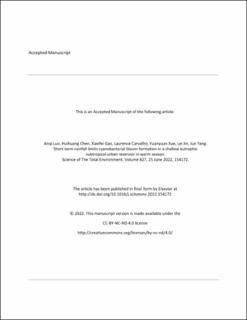| dc.contributor.author | Luo, Anqi | |
| dc.contributor.author | Chen, Huihuang | |
| dc.contributor.author | Gao, Xiaofei | |
| dc.contributor.author | Carvalho, Laurence | |
| dc.contributor.author | Xue, Yuanyuan | |
| dc.contributor.author | Jin, Lei | |
| dc.contributor.author | Yang, Jun | |
| dc.date.accessioned | 2022-05-30T10:17:35Z | |
| dc.date.available | 2022-05-30T10:17:35Z | |
| dc.date.created | 2022-03-04T09:21:55Z | |
| dc.date.issued | 2022 | |
| dc.identifier.citation | Science of the Total Environment. 2022, 827, 154172. | en_US |
| dc.identifier.issn | 0048-9697 | |
| dc.identifier.uri | https://hdl.handle.net/11250/2996722 | |
| dc.description | Embargo until February 26, 2024. | en_US |
| dc.description.abstract | The global increase in dominance of toxic blooms of cyanobacteria has severely impacted aquatic ecosystems and threatened human health for decades. Although it has been shown that high levels of rainfall may inhibit the growth of bloom-forming cyanobacteria, it is still unclear how cyanobacteria respond to short-term rainfall events. Based on five-year (2016–2020) high-frequency (half-week) sampling data from a shallow eutrophic urban reservoir in subtropical China, we explored the short-term effects of rainfall events on cyanobacterial biomass (CBB) by constructing general additive models of CBB in rainy periods during warm (April to September) and cool (December and January) months, respectively. We find evidence in support of the hypotheses that short-term rainfall events significantly reduce CBB in warm months, but the opposite response was observed in the cool months. We also highlight a difference in the factors explaining CBB decreases in warm months (precipitation, air temperature, relative humidity, dissolved oxygen and total phosphorus) compared with factors explaining the response of CBB in cool months (sunshine hours, pH and total carbon). In particular, meteorological factors (precipitation, wind speed and sunlight) might drive changes in water temperature and hydro-dynamics of the reservoir, thereby causing a rapid reduction of CBB after rainfall events in warm months. This varying response of cyanobacteria to short-term rainfall events in the shallow eutrophic subtropical reservoir may also be expected in temperate or cool lakes as climate change effects become stronger. | en_US |
| dc.language.iso | eng | en_US |
| dc.publisher | Elsevier | en_US |
| dc.rights | Attribution-NonCommercial-NoDerivatives 4.0 Internasjonal | * |
| dc.rights.uri | http://creativecommons.org/licenses/by-nc-nd/4.0/deed.no | * |
| dc.title | Short-term rainfall limits cyanobacterial bloom formation in a shallow eutrophic subtropical urban reservoir in warm season | en_US |
| dc.type | Peer reviewed | en_US |
| dc.type | Journal article | en_US |
| dc.description.version | acceptedVersion | en_US |
| dc.source.pagenumber | 9 | en_US |
| dc.source.volume | 827 | en_US |
| dc.source.journal | Science of the Total Environment | en_US |
| dc.identifier.doi | 10.1016/j.scitotenv.2022.154172 | |
| dc.identifier.cristin | 2007512 | |
| dc.source.articlenumber | 154172 | en_US |
| cristin.ispublished | true | |
| cristin.fulltext | postprint | |
| cristin.qualitycode | 2 | |

